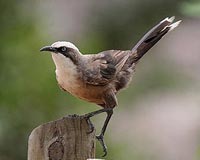 |
Ann Arbor MI (SPX) Aug 14, 2009 A period of global warming from 53 million to 47 million years ago strongly influenced plants and animals, spurring a biodiversity boom in western North America, researchers from three research museums report in a paper published online in the Proceedings of the National Academy of Sciences. "Today, the middle of Wyoming is a vast desert, and a few antelope and deer are all you see," said lead author Michael Woodburne, honorary curator of geology at the Museum of Northern Arizona. "But 50 million years ago, when temperatures were at their highest, that area was a tropical rainforest teeming with lemur-like primates, small dawn horses and a number of small forest rodents and other mammals. In fact, there were more species of mammals living in the western part of North America at that time than at any other time." Woodburne and co-authors Gregg Gunnell of the University of Michigan Museum of Paleontology and Richard Stucky of the Denver Museum of Nature and Science examined the records of ancient temperatures and information on the fossil plants and mammals that inhabited North America during the Eocene epoch and found that diversity increased and declined with rising and falling temperatures. The Eocene began about 56 million years ago with a short period of increased warming, when many modern groups of mammals first appeared in North America, probably by emigrating from other areas. The period the researchers studied, called the Early Eocene Climatic Optimum (EECO), began about three million years later and included a long-term temperature increase coupled with a long-term rise in diversity. During that time, as mean annual temperature warmed from about 60 degrees Fahrenheit to 73 degrees Fahrenheit (15 degrees Celsius to 23 degrees Celsius), vegetation changed, with many new plant forms appearing, and mammal diversity increased from 90 genera to an all-time high of 104 genera, the researchers found. "This is also the part of the Eocene when we see the most new appearances of mammals due to evolutionary innovation, rather than immigration," said Stucky, who is curator of paleoecology and evolution at the Denver Museum of Nature and Science. Some 30 new rodents, carnivores, primates and artiodactyls (the group that includes sheep, goats, camels, pigs, cows, deer, giraffes and antelopes, among others) appeared on the scene. But then, as temperatures declined again, the number of mammal genera dropped to a low of 84, with the complete loss of many mammalian groups that previously were well represented. Lower temperatures and a dryer climate continued to influence mammal and plant evolution as savanna habitats began to emerge. Until this research, the consensus among paleontologists who study North American vertebrates was that climate played only a background role in supporting the evolution of mammals during the Paleocene and Eocene (65 million to 35 million years ago) and that only at the end of the Eocene, when Antarctic glaciations began, did Earth's climate deteriorate enough to cause observable changes in land mammal diversity. "Our paper documents the fact that global change affected plants and animals on a wide scale," said Gunnell, an associate research scientist and vertebrate collection coordinator at the U-M Museum of Paleontology. "Some plants and animals flourished while others suffered." When considering today's global warming, Woodburne said, "The question is, on which side of this picture will mankind be found?" Share This Article With Planet Earth
Related Links University of Michigan Darwin Today At TerraDaily.com
 Climate change turning Aussie birds into featherweights: study
Climate change turning Aussie birds into featherweights: studyMelbourne (AFP) Aug 13, 2009 Australian birds have shrunk over the past century because of global warming, scientists have found. Using museum specimens, researchers measured the size of eight bird species and discovered they were getting smaller in an apparent response to climate change. Australian National University (ANU) biologist Janet Gardner said modern birds were up to four percent smaller than their ... read more |
|
| The content herein, unless otherwise known to be public domain, are Copyright 1995-2009 - SpaceDaily. AFP and UPI Wire Stories are copyright Agence France-Presse and United Press International. ESA Portal Reports are copyright European Space Agency. All NASA sourced material is public domain. Additional copyrights may apply in whole or part to other bona fide parties. Advertising does not imply endorsement,agreement or approval of any opinions, statements or information provided by SpaceDaily on any Web page published or hosted by SpaceDaily. Privacy Statement |